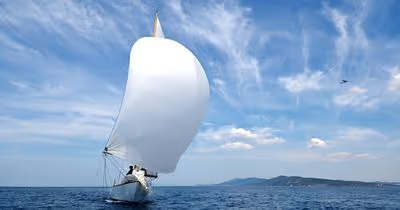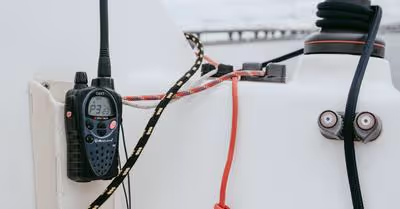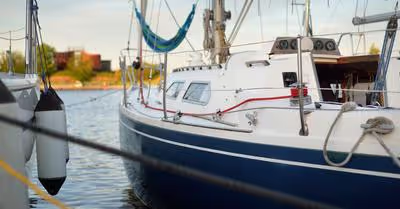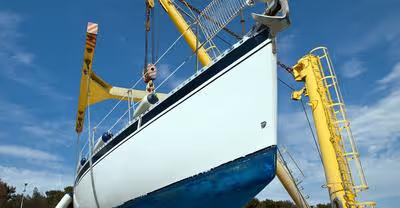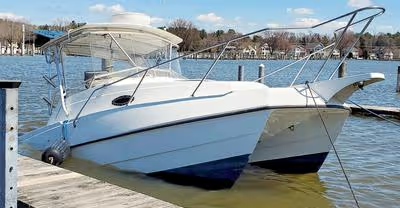Table of Contents
What is A Mooring Ball?
Most mooring balls follow a similar setup, which comprises a heavy anchor such as a concrete block resting on the bottom of the ocean. This weight is attached using a heavy chain to a mooring ball floating on the water's surface. The mooring ball or buoys have eyelets or loops on top to allow ships and boats to tie in.
Depending on their purpose, the weight that serves as an anchor can vary. For boats, an engine block can easily hold them in place. But for larger ships, the anchor often needs to be bolted down into the bedrocks. The weight and size of the chain tying the ball to the anchor also vary.
The mooring balls come in different shapes and sizes and can be used to moor small sailboats and even large ships. In addition to not being able to drop the anchor, there are several other reasons why mooring balls are used in the sea.
- Large boats or ships can often damage marine life, such as coral reefs near the coastline with large and deep hulls. These vessels can be kept far away from danger zones by keeping them tied to mooring balls out in the ocean.
- If the seafloor surface is not suitable for anchoring or the water is too deep, mooring balls can be installed to hold ships in place.
- Anchoring is not as simple as just letting the anchor free fall; certain techniques are involved. Many sailors find tying to a mooring ball easier than handling the anchor.
How To Grab A Mooring Ball
Like all other sailing adventures, attempting to tie onto a mooring ball can seem daunting. But it doesn't have to be that way. Knowing the proper techniques significantly increases your chances of grabbing the mooring ring in your first attempt.
To begin with, you will require three lines attached to the bow. You will use two lines to keep your boat secured during your stopover. The third line needs to be heavy and should sink without delay. This is the line you will use to approach the ball.
You will require a long pole with a hook to grab the eyelet or loop attached to the mooring ball. You will attempt to get a heavy line through the eyelet on the mooring ball and then pull yourself in. This practice will give you a good idea of the strength of the mooring ball.
As you approach the mooring ball, you must create a loop with the heavy line. You will then toss it over the ball in a similar fashion as when tying to a piling. The bar has to sink below the mooring ball, which is why you need a heavy line.
Once you have the line in the loop, your boat will move away from the mooring ball, and this will give you a good idea about the strength of the mooring ball and whether it is suitable for the size and weight of your boat.
Sailing Solo
If you prefer sailing alone and you need to tie up to a mooring ball, you will have to follow the same technique to grab the ball. However, during solo adventures, it will be better if you can pull over beside the mooring ball until it is visible from the cockpit.
You will then attempt to toss a loop of your heavy line over the ball. While holding both ends of the line, you can walk over to the boat's bow and tie them to any cleat on the boat. Ensure that your boat is neutral and free to move along the water as you are tying up. This will allow you to keep the rope taut and give less room for your boat to move.
How To Tie A Sailboat To A Mooring Ball Ring?
Now that you have a temporary line holding the boat in place with the ring, you can give yourself a pat on the back, relax, and plan your next moves.
For the two lines running from the bow, you will need to attach one to the starboard cleat and the other to the port cleat. The other end of each rope will need to be run through the eyelet or ring on the mooring ball. You will then have to bring the end back and tie it to the cleat the rope is starting from.
Most mooring ball rings are attached to pennants, making it easier to access the ring. A longboat hook will be handy for passing the rope through the ring, making the job much easier. If your boat is too high or you cannot access the ring while onboard, you will need to use a dinghy to the mooring ring, and you can pass the lines through the ring by hand.
The benefit of using two lines is that it significantly reduces damage to the boat due to the rope grinding against the surface. Your boat will move more on a single rope due to water currents and the wind. Remember, the rope is first tied to a cleat, goes through the mooring ring, and then comes back to the same cleat and tied off.
Types of Moorings
Many different types of moorings can be used to tie boats. The most common type is the dock, a fixed platform made of wood, concrete, or metal attached to the shore. Docks are usually used for smaller boats, and they provide a place to tie up your boat and keep it safe from waves and currents.
Another type of mooring is the buoy. Buoys are floating devices anchored to the bottom of a body of water. They are often used for larger boats because they can be moved around easily, and they don't require a fixed structure like a dock.
Moorings can also be made from natural materials like trees or rocks. These moorings are less common, but they can be just as effective as man-made structures. They were used historically, but with the increased traffic and sailors mooring their boats in the middle of the ocean, these natural moorings have lost their popularity.
No matter what type of mooring you use, it's essential to ensure that it is secure and holds your boat in place. Always check the condition of your moorings before using them, and be sure to replace them if they show any signs of wear or damage.
Types of Knots for Moorings
Mooring your boat correctly requires the use of good knots. The most common knot used for moorings is the bowline, a simple and strong knot that can be easily tied and untied. Other popular knots include the bowline, clove hitch, and half hitch.
When selecting a knot for your mooring lines, it's essential to choose one appropriate for the size and type of boat you are using. It would be best to consider the conditions in which you'll be using the knot, as some knots are better suited for calm waters while others can withstand more turbulent conditions.
Mooring lines are an essential part of keeping your boat secure. By selecting the correct type of knot, you can ensure that your boat stays where it should be. Practice tying different knots until you find ones that work well for you and your boat. With a bit of practice, you'll be able to tie the perfect knot for any mooring situation.
The Bowline Knot
The bowline allows you to create a loop towards the rope's end. This loop can be used for several reasons, such as attaching two ropes together or attaching the rope to a piling. The bowline is easy to undo, even if the knot has gone through considerable pulls and tugs.
To make the bowline knot, you will need to:
- Make a small loop in the line, a few feet from the rope's end, and then pass the loose end through the loop.
- Wrap the loose end over the mainline above the loop, and then pass it through the loop again.
- Tug on the loose end firmly to tighten as much as you can. Also, tug on the line above the loop to ensure that the knot is tight and snug.
The Cleat Hitch Knot
The cleat hitch knot is one of the most commonly used knots in sailing, and for a good reason. It's quick and easy to tie, and it can be used for various purposes. One reason for its popularity is its simplicity.
To make the cleat hitch:
- Make a loop around the cleat, usually done below the horns.
- Cross the line over the top of the cleat, and loop it again under the horn
- Change directions, and begin by looping over the cleat, going in the other direction.
- To finalize the knot, change direction again, and aim the rope as if you were going to tie it below the horns. But instead of looping the cleat, make a small loop, and pass the end of the rope through it. Pull as hard as you can to allow the line to grab onto itself.
Another way to make a cleat hitch is to take the rope in your hand and make a loop around the cleat. Then, cross the rope over itself and tuck it under the loop. Next, pull the rope tight so that the knot is snug against the cleat. Finally, give the end of the rope a couple of twists to secure it in place.
The Figure Eight Knot
Figure 8 comes in handy when you need to prevent a line from passing through an eyelet or a ring such as a pulley or a chock. This knot can be pretty challenging to open if it is subject to several forces. To make the figure eight:
- Begin by making a simple loop in the line
- Wrap the end over the line, and run it through the loop.
- Tug at both ends to tighten, and push to pull the knot to adjust its location, and then finalize by tightening it
The Half Hitch Knot
The half hitch is probably the simplest knot ever invented. These knots are durable or reliable if used only by themselves. But they are a good option if you want to secure the line after tying your boat using a different knot. Even if you use two half hitch knots together, you can use them to secure light loads.
All you need to do to tie this knot is pass the line's end over the mainline, make a loop, and put the loose end through the loop. Tug at the main rope and the loose end, and you are done.
Types of Ropes for Moorings
The type of rope you use for your moorings is just as important as the type of knot. There are many different types of ropes available, and each has its strengths and weaknesses. The most common rope used for moorings is nylon, which is strong and durable. Other popular options include polypropylene, Kevlar, and Dacron.
When selecting a rope for your moorings, it's essential to choose one appropriate for the size and type of boat you are using. It would help if you also considered the conditions in which you'll be using the rope, as some ropes are better suited for calm waters while others can withstand more turbulent conditions.
Ropes are an essential part of keeping your boat secure. By selecting the correct type of rope, you can ensure that your boat stays where it should be. No matter what type of rope you choose, it's essential to ensure that it is in good condition before using it. Inspect your ropes regularly and replace them when necessary to ensure that your boat stays safe and secure.
Recent Articles




